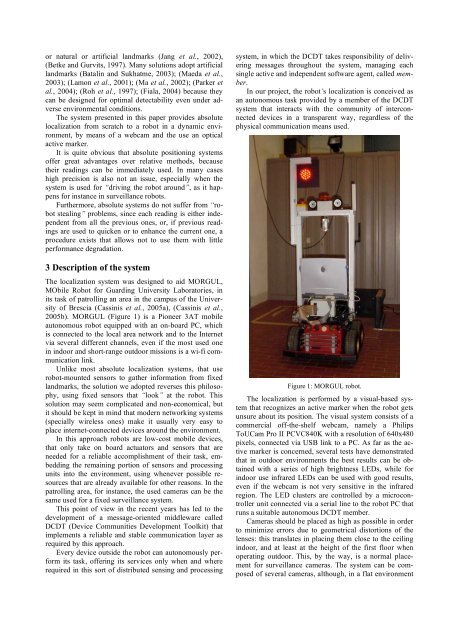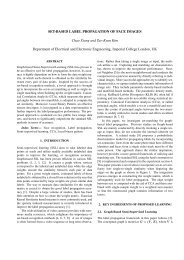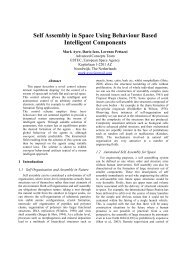Active markers for outdoor and indoor robot localization
Active markers for outdoor and indoor robot localization
Active markers for outdoor and indoor robot localization
You also want an ePaper? Increase the reach of your titles
YUMPU automatically turns print PDFs into web optimized ePapers that Google loves.
or natural or artificial l<strong>and</strong>marks (Jang et al., 2002),<br />
(Betke <strong>and</strong> Gurvits, 1997). Many solutions adopt artificial<br />
l<strong>and</strong>marks (Batalin <strong>and</strong> Sukhatme, 2003); (Maeda et al.,<br />
2003); (Lamon et al., 2001); (Ma et al., 2002); (Parker et<br />
al., 2004); (Roh et al., 1997); (Fiala, 2004) because they<br />
can be designed <strong>for</strong> optimal detectability even under adverse<br />
environmental conditions.<br />
The system presented in this paper provides absolute<br />
<strong>localization</strong> from scratch to a <strong>robot</strong> in a dynamic environment,<br />
by means of a webcam <strong>and</strong> the use an optical<br />
active marker.<br />
It is quite obvious that absolute positioning systems<br />
offer great advantages over relative methods, because<br />
their readings can be immediately used. In many cases<br />
high precision is also not an issue, especially when the<br />
system is used <strong>for</strong> “driving the <strong>robot</strong> around”, as it happens<br />
<strong>for</strong> instance in surveillance <strong>robot</strong>s.<br />
Furthermore, absolute systems do not suffer from “<strong>robot</strong><br />
stealing” problems, since each reading is either independent<br />
from all the previous ones, or, if previous readings<br />
are used to quicken or to enhance the current one, a<br />
procedure exists that allows not to use them with little<br />
per<strong>for</strong>mance degradation.<br />
3 Description of the system<br />
The <strong>localization</strong> system was designed to aid MORGUL,<br />
MObile Robot <strong>for</strong> Guarding University Laboratories, in<br />
its task of patrolling an area in the campus of the University<br />
of Brescia (Cassinis et al., 2005a), (Cassinis et al.,<br />
2005b). MORGUL (Figure 1) is a Pioneer 3AT mobile<br />
autonomous <strong>robot</strong> equipped with an on-board PC, which<br />
is connected to the local area network <strong>and</strong> to the Internet<br />
via several different channels, even if the most used one<br />
in <strong>indoor</strong> <strong>and</strong> short-range <strong>outdoor</strong> missions is a wi-fi communication<br />
link.<br />
Unlike most absolute <strong>localization</strong> systems, that use<br />
<strong>robot</strong>-mounted sensors to gather in<strong>for</strong>mation from fixed<br />
l<strong>and</strong>marks, the solution we adopted reverses this philosophy,<br />
using fixed sensors that “look” at the <strong>robot</strong>. This<br />
solution may seem complicated <strong>and</strong> non-economical, but<br />
it should be kept in mind that modern networking systems<br />
(specially wireless ones) make it usually very easy to<br />
place internet-connected devices around the environment.<br />
In this approach <strong>robot</strong>s are low-cost mobile devices,<br />
that only take on board actuators <strong>and</strong> sensors that are<br />
needed <strong>for</strong> a reliable accomplishment of their task, embedding<br />
the remaining portion of sensors <strong>and</strong> processing<br />
units into the environment, using whenever possible resources<br />
that are already available <strong>for</strong> other reasons. In the<br />
patrolling area, <strong>for</strong> instance, the used cameras can be the<br />
same used <strong>for</strong> a fixed surveillance system.<br />
This point of view in the recent years has led to the<br />
development of a message-oriented middleware called<br />
DCDT (Device Communities Development Toolkit) that<br />
implements a reliable <strong>and</strong> stable communication layer as<br />
required by this approach.<br />
Every device outside the <strong>robot</strong> can autonomously per<strong>for</strong>m<br />
its task, offering its services only when <strong>and</strong> where<br />
required in this sort of distributed sensing <strong>and</strong> processing<br />
system, in which the DCDT takes responsibility of delivering<br />
messages throughout the system, managing each<br />
single active <strong>and</strong> independent software agent, called member.<br />
In our project, the <strong>robot</strong>’s <strong>localization</strong> is conceived as<br />
an autonomous task provided by a member of the DCDT<br />
system that interacts with the community of interconnected<br />
devices in a transparent way, regardless of the<br />
physical communication means used.<br />
Figure 1: MORGUL <strong>robot</strong>.<br />
The <strong>localization</strong> is per<strong>for</strong>med by a visual-based system<br />
that recognizes an active marker when the <strong>robot</strong> gets<br />
unsure about its position. The visual system consists of a<br />
commercial off-the-shelf webcam, namely a Philips<br />
ToUCam Pro II PCVC840K with a resolution of 640x480<br />
pixels, connected via USB link to a PC. As far as the active<br />
marker is concerned, several tests have demonstrated<br />
that in <strong>outdoor</strong> environments the best results can be obtained<br />
with a series of high brightness LEDs, while <strong>for</strong><br />
<strong>indoor</strong> use infrared LEDs can be used with good results,<br />
even if the webcam is not very sensitive in the infrared<br />
region. The LED clusters are controlled by a microcontroller<br />
unit connected via a serial line to the <strong>robot</strong> PC that<br />
runs a suitable autonomous DCDT member.<br />
Cameras should be placed as high as possible in order<br />
to minimize errors due to geometrical distortions of the<br />
lenses: this translates in placing them close to the ceiling<br />
<strong>indoor</strong>, <strong>and</strong> at least at the height of the first floor when<br />
operating <strong>outdoor</strong>. This, by the way, is a normal placement<br />
<strong>for</strong> surveillance cameras. The system can be composed<br />
of several cameras, although, in a flat environment




